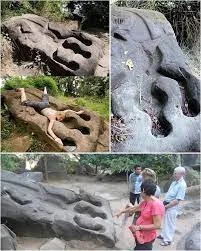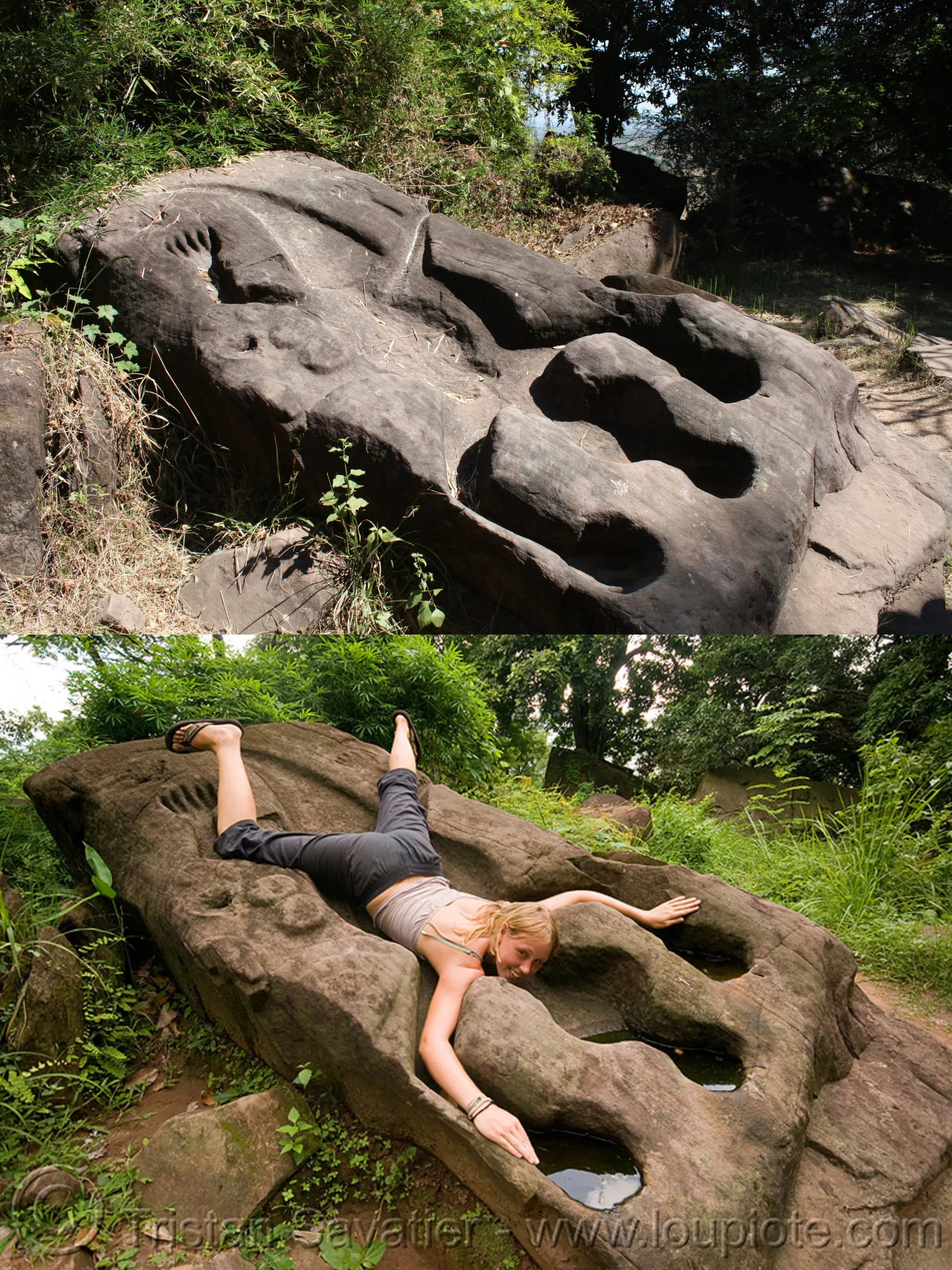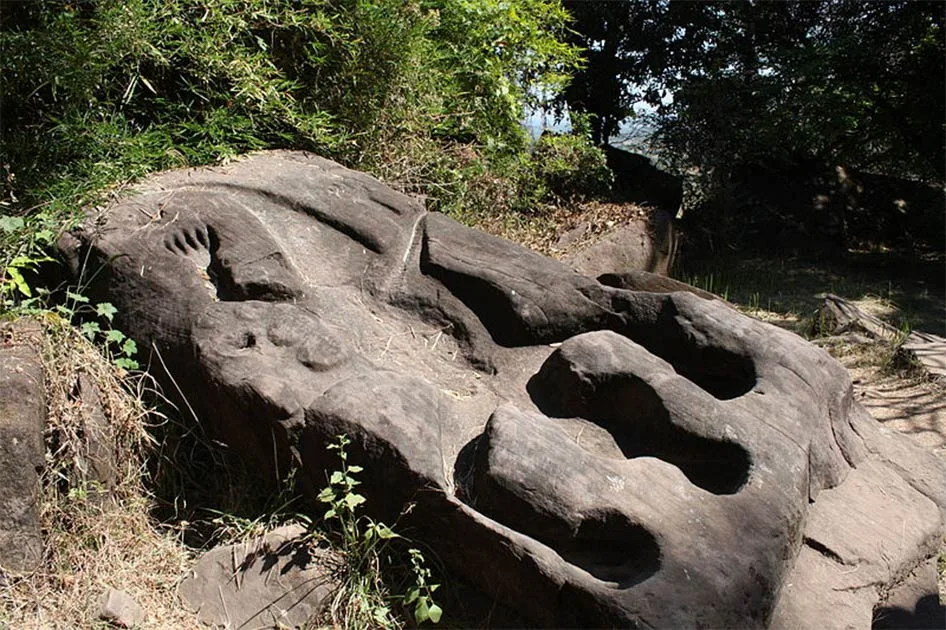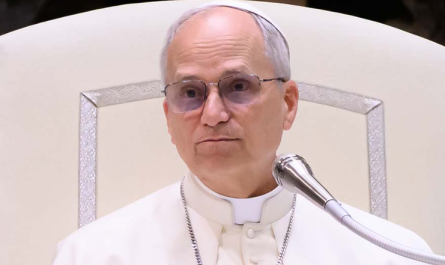The Crocodile Stone is a peculiar rock, located in the Vat Phou Temple complex in Laos, that contains the carving of a crocodile. It was possibly the site of an annual human sacrifice in pre-Angkorian times (before the 9th century CE)

The Crocodile Stone of Vat Phou: Mystery of an Ancient Carving
Nestled within the Vat Phou Temple complex in Champasak Province, southern Laos, the Crocodile Stone is an enigmatic relic that has sparked intrigue and debate. This peculiar rock, carved with the shape of a crocodile, dates to pre-Angkorian times, possibly as early as the 2nd century BCE, and is part of a UNESCO World Heritage Site. Its human-sized indentation has led to speculation that it served as an altar for annual human sacrifices, though evidence remains inconclusive. The stone’s mystery, set against the backdrop of Vat Phou’s ancient Khmer-Hindu architecture, offers a tantalizing glimpse into the spiritual and cultural practices of a lost era.

The Vat Phou Temple Complex
Vat Phou, meaning “temple-mountain,” is one of Southeast Asia’s oldest worship sites, located at the base of Phou Kao Mountain, 6 kilometers from the Mekong River. Its earliest structures, including the Crocodile Stone, serpent stairs, and offering platforms, date to the 2nd century BCE, with significant construction occurring from the 5th to 13th centuries during the Khmer Empire’s dominance. The temple, originally dedicated to the Hindu god Shiva, was later converted to Theravada Buddhist use in the 13th century and remains an active religious site, hosting the annual Vat Phou Festival each February. The complex’s east-west axis, aligned with the mountain and river, reflects a symbolic Hindu vision of harmony between nature and humanity.

The Crocodile Stone: Description and Speculation
The Crocodile Stone, located near the upper terrace of Vat Phou, is a boulder with a deep, crocodile-shaped impression, roughly the size of a human body. Its dimensions—approximately 1.5 meters long—have fueled speculation that it was used for human sacrifices in pre-Angkorian times (before the 9th century CE). A 6th-century Chinese text, the Sui Chronicles, mentions human sacrifice practices in the region, possibly by the Chenla Kingdom, which ruled southern Laos before the Khmer Empire. The text’s vague reference to a crocodile has led some to link it to the stone, though no direct evidence ties the two. The stone’s uniqueness—no similar carvings exist in Laos or Cambodia—adds to its mystery.

Debating the Human Sacrifice Theory
The human sacrifice hypothesis stems from the stone’s human-like proportions and the Sui Chronicles’ account, but it remains speculative. No physical evidence, such as human remains or sacrificial tools, has been found at the site, and the Chronicles do not explicitly reference Vat Phou or the Crocodile Stone. Local legends and the absence of crocodile worship in Khmer or Chenla religious traditions further complicate the theory. Some propose the stone may have been a water-collecting basin, given its proximity to a sacred spring and the region’s periodic droughts. If originally horizontal, the carving could have held water for rituals, aligning with the temple’s focus on Shiva and water-based ceremonies. Others suggest it was purely symbolic, perhaps linked to local myths or natural features, as the nearby Phou Kao Mountain resembles a linga, a Shiva symbol.
Cultural and Archaeological Context
The Crocodile Stone predates most of Vat Phou’s surviving structures, which were built during the Khmer Empire’s Koh Ker and Baphuon periods (11th century). The temple complex includes other carvings, such as an elephant stone (possibly 16th century) and a Buddha footprint, reflecting its evolution from a Hindu to a Buddhist site. The stone’s lack of religious context—crocodiles held no known spiritual significance in the region—sets it apart from typical Khmer iconography, like the naga (serpent) balustrades or Shiva lingams. Its preservation, despite centuries of exposure, underscores the site’s enduring significance, though modern tourism poses risks of erosion from visitors climbing on it.
A Lasting Enigma
The Crocodile Stone remains one of Vat Phou’s most intriguing features, its purpose obscured by time and sparse evidence. Whether an altar for sacrifice, a ritual basin, or a symbolic carving, it reflects the complex spiritual landscape of pre-Angkorian Laos. Like other ancient relics, such as the Dolmen de Bagneux or the White Horse of Uffington, it speaks to humanity’s impulse to shape the natural world for cultural or sacred ends. As a UNESCO-protected site, the Crocodile Stone continues to captivate, inviting speculation about the rituals and beliefs of those who carved it over two millennia ago.


